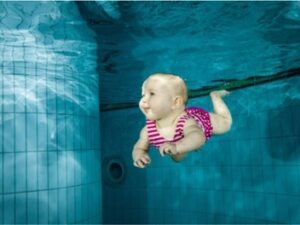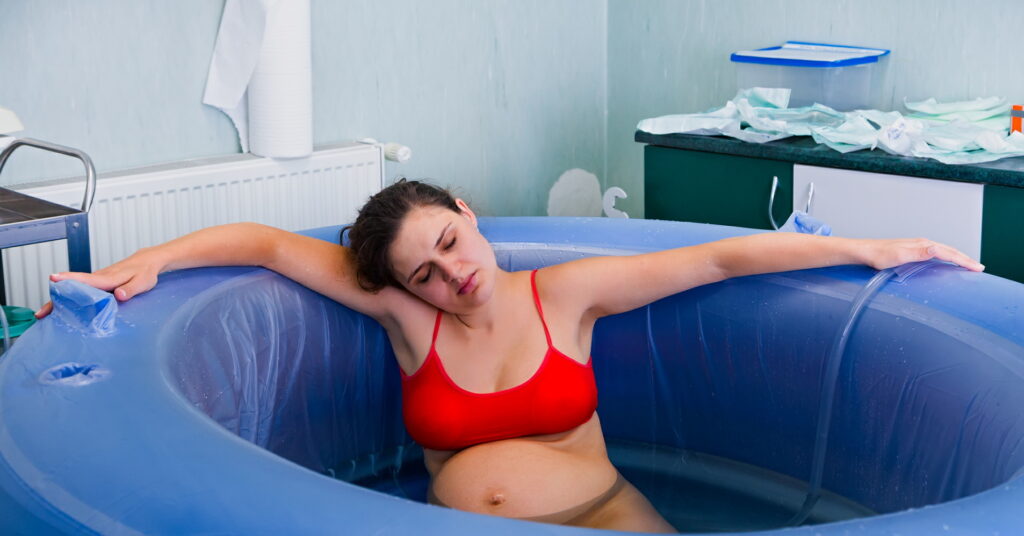Over the past decade there has been a steady rise of women taking back control over where and how they birth their babies. Along with this has come an increased interest in water birth. But is this just a craze and is it safe?
Water birth has a long history dating back to ancient civilizations. Ancient Egyptians used water during labour and delivery, and there are also records of water birth in traditional practices in various parts of the world, such as Indonesia and Central and South America. The first western water birth was recorded in 1805 when a woman who had been labouring many hours decided to take a bath. Her labour quickly progressed and with a sudden need to push, her child was born into the water.
In the 1970s, French obstetrician Michel Odent began installing warm water birthing pools in his maternity unit, believing that birth had become too medicalised and that water birth could help reduce pain and stress for the mother and the baby during labour and delivery.
As with all things that challenge the status quo, Odent’s ideas were met with scepticism and criticism from the medical community. Many doctors were concerned about the safety and hygiene of water birth, believing it could lead to complications. Despite this, Odent persisted in his research and advocacy for water birth, and by the 1980s water birth had gained popularity in Europe and the US and become more widely accepted among medical professionals.

In Australia most hospitals now offer women the option of labouring in the tub, acknowledging the many benefits of warm water immersion: pain relief and reduced need for drugs; acceleration of labour; relaxation and energy conservation.
However, while many obstetricians will “allow” a woman to labour in the tub, most still draw the line there and request that the mother exit the water for the actual birth. Those hospitals that claim to endorse birthing in water have strict eligibility criteria. This may be because these “high risk” mothers are deemed to need more medical interventions, which are hard to achieve in water. Interestingly, this is partially the reason why Odent made his birthing pools so wide and deep – limited intervention!
Today most opponents of water birth cite the following concerns: risk of infection, cord rupture and drowning. Let’s look at these more closely.
Infection
It has been suggested that the primary risk of infection during water birth is the introduction of bacteria into the birthing pool or tub from the mother’s skin, faecal matter, or other sources. But this goes against much of what we now know about gut microbes.
Among mammals, humans are the only ones to fear bacteria – a fear that has done much damage to our gut health. In nature, new born elephants, giant pandas, koalas, and hippos all eat their mother’s poo and in doing so, obtain the bacteria required to properly digest vegetation found in their ecosystems.
Similarly, when a human baby passes through the birth canal during a vaginal delivery (whether in water or not), it comes into contact with the microbes present in the mother’s vagina and rectum. These microbes play a large part in the initial colonisation of a baby’s gut. These bacteria along with those gained from breastfeeding and skin-to-skin time in the first few days and weeks of a baby’s life can have a significant impact on their health and immune system development.
Cord Rupture
Cord rupture is a rare but serious risk that involves the partial or complete separation of the umbilical cord from either the baby or placenta. Documented causes include haematomas (pooled blood), having a short cord, inflammation and incorrect cord attachment in early pregnancy.
During any birth there is a potential risk of cord rupture if the umbilical cord becomes excessively stretched or tangled. This can happen if the baby moves rapidly or forcefully while still attached to the placenta. Cord rupture is often attributed to water birth because the water’s buoyancy may allow the baby to move more freely and also any hurried movements to bring the baby up out of the water may not take into consideration the length of the cord.
This can be avoided by bringing the baby out of the water slowly and gently after birth. Guiding the baby’s head and shoulders out of the water and having awareness of the cord as the baby’s body is lifted onto the mother.

Why the baby doesn’t drown when the head is out but is still in the water?
When a baby is born into water there are three main protective features that prevent them from breathing in while they are underwater: fluid-filled lungs; labour hormones; and the dive reflex.
Even when birth occurs “on land,” the baby does not take their first breath until their body has been fully birthed. This is because the baby’s lungs are filled with amniotic fluid during pregnancy and birth. This fluid helps protect and develop the lungs. The baby practices “breathing” by inhaling and exhaling amniotic fluid, which strengthens respiratory muscles. These are called foetal breathing movements (FBM).
As labour approaches, hormonal shifts in the mother’s body prepare her and her baby for labour. As contractions begin, decreasing levels of progesterone and increasing levels of cortisol trigger the slowing and temporary cessation of FBMs. This means the baby is literally holding their “breath” during birth, allowing them to conserve energy and redirect blood flow to vital organs, such as the brain and heart.
After the baby’s head is born, the baby’s chest and lungs are still compressed by the mother’s vaginal muscles, which further prevent the baby from taking their first breath.
The next thing that prevents a baby breathing it water is the dive reflex. Babies are born with a number of automatic reflexes that do not require conscious effort from the baby, and disappear after the first few months as the baby’s nervous system develops.
During a water birth, the dive reflex is triggered by the sensation of water on the baby’s face or body, causing the baby to hold its breath and preventing them from inhaling water. This lack of breath is not detrimental to the baby as long as they are still connected to the mother via the placenta; receiving oxygen-rich blood.
As the baby’s body is born, their chest and lungs are no longer compressed, and coming up from the water, the baby’s face is exposed to air, triggering the reflex that causes the baby to take their first breath. With that first breath, many dramatic changes must take place in the baby’s body (cardiovascular and respiratory systems) to allow the baby’s respiratory system to function independently.
During this transition the amniotic fluid is cleared through a combination of pressure, absorption, swallowing and coughing. Pressure on the chest helps to squeeze amniotic fluid from of the lungs. Then, when the baby takes their first breath, air enters the lungs, further clearing the fluid. Although this transition begins the instant a baby takes their first breath, it takes about 5 minutes for the baby’s skin to turn pink, indicating improved oxygenation.

Nature’s resuscitation station (Skin-to-Skin / Delayed Clamping)
One of the many benefits of water birth is that the baby is usually brought up to the mother’s chest or tummy while still connected via the umbilical cord. No one is taking the baby away to be suctioned, weighed or measured. Some midwives still reach in to wipe the baby’s face or use the bulb syringe to “help” clear the airways, but this is often more out of habit than necessity (and can ironically trigger a reflex similar to the dive reflex discouraging them from breathing).
The power of immediate and uninterrupted skin-to-skin time between a mother and her child cannot be overstated. This act alone has been shown to regulate many of the newborn’s systems – a divinely designed resuscitation station after a somewhat turbulent entry into the world. In the next 72 hours, skin-to-skin contact also stimulates the baby’s lymphatic system to draw out any remaining fluid from the lungs that wasn’t expelled during birth or taken up by the respiratory blood system.
Delayed cord clamping also assists a baby’s transition to breathing on its own by allowing the baby to continue receiving oxygen-rich blood from the placenta through the umbilical cord for a longer period of time. After birth, it takes 3-5 breaths for the airways to clear, however it takes up to 4 hours for the liquid in the lungs to fully absorb into surrounding tissue and blood system. Delayed cord clamping and uninterrupted skin-to-skin provides unrushed time for the baby’s lungs to expand and fill with air, and for the heart to adjust to the increased blood flow that comes with breathing on its own.
Why are more women choosing to have a water birth?
From Epsom salt baths to spas and float tanks, most people today associate warm water emersion with relaxation, and the ability to relax during labour helps to break the Fear-Tension-Pain cycle. Labouring in warm water brings a multitude of benefits like being able to easily change position; helping the perineum to relax and stretch; less unwanted interventions (like vaginal examinations); and immediate skin-to-skin time (nature’s resus station).
As women become more educated about birth and the many birthing options available to them, more and more are recognising these benefits and choosing water immersion as part of their birthing journey.

What’s needed for a water birth?
If you’re planning to have a water birth here are some things to gather in preparation:
- Inflatable birthing pool or bath +/- pool liner
- Water thermometer
- New hose for filling (if using pool + connector for house tap)
- Pots for heating extra water (if using pool)
- Containers for bringing hot tap water (if using pool)
- Lots of old/dark towels (that can get soiled)
- Large plastic bags for soiled laundry
- Tarp or plastic tablecloth to go under birthing pool
- Waterproof mat/sheet, cushions, pillows beside pool or on bed for when you decide to get out
- Other birthing tools such as ball, CUB stool, rebozo, etc for if you decide to birth out of the tub
- Cup/jug for pouring water on mum’s back
- Torch and hand mirror for viewing
- Fish net for removing any solid matter from the water
- Heater or fan for the room
- Bowl for placenta
- Blanket to cover mother and baby after birth if needed
- Clamp and scissors for cutting umbilical cord (if applicable)
- Maternity pads / pull ups for after the birth
- Light food and drinks for mum for during labour
- Warm, nutrient dense food and drink for after birth
My name is Krista Cue, and I am a qualified doula who has trained at the Doula Training Academy. If you would like more information about my doula services, please contact me:
Phone:
0490 253 248
Email:
[email protected]
Website:
www.nourishedmothers.com.au (coming soon)

